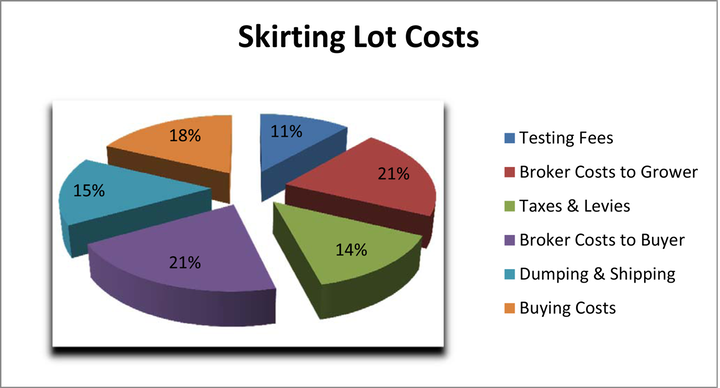In this section we will look at a skirting lot. Now to avoid verbose repetition we will assume that the Fleece lot has already been ‘followed’. That is, we will not repeat the same background notes – just show the differences.
We have also deliberately selected a lot that was sold by the same broker – so the same broker charge structures applied; and purchased by the same buyer for similar reasons.
The lot selected was a 19.4 micron lot valued by the broker as a MB5S.
The buyer valued the lot and was prepared to pay up to 1175 clean and 647 greasy c/kg.
Now the buyer bought the lot at 686 – a ‘loss’ of nearly 40 greasy c/kg. We do not know why the buyer took that ‘loss’. It could have been that he was under his average for the order, or was willing to take a loss, or considered that the market was going to get worse etc.
The buyer margins were the same as the lot was going to the same destination etc.
The lot cost breakdowns are therefore summarised as follows:
Again all costs are shown in greasy cents / kg, as this is the terminology used by most growers.
11.78 - AWTA Testing fees
21.15 - broker costs to grower
14.17 - other costs auction to grower
21.30 - broker costs to buyer
15.75 - direct dumping & shipping costs
18.26 - buyer costs for finance, staffing, contract costs, profit etc.
Total costs = 102.41 greasy c/kg.
Now these costs are signifantly lower than for the fleece lot when shown as greasy c/kg - the fleece lot was 129 c/kg.
However on a per bale basis the skirting lot is $169 per bale, while the fleece lot was $172 per bale. This is due to the fact that many costs were on a per bale (brokerage, dumping. storage) or per lot (testing).
Then again the costs on a gross proceeds basis are yet again signifantly different with the skirting lot having a 25% cost factor, and the fleece lot 14%.

